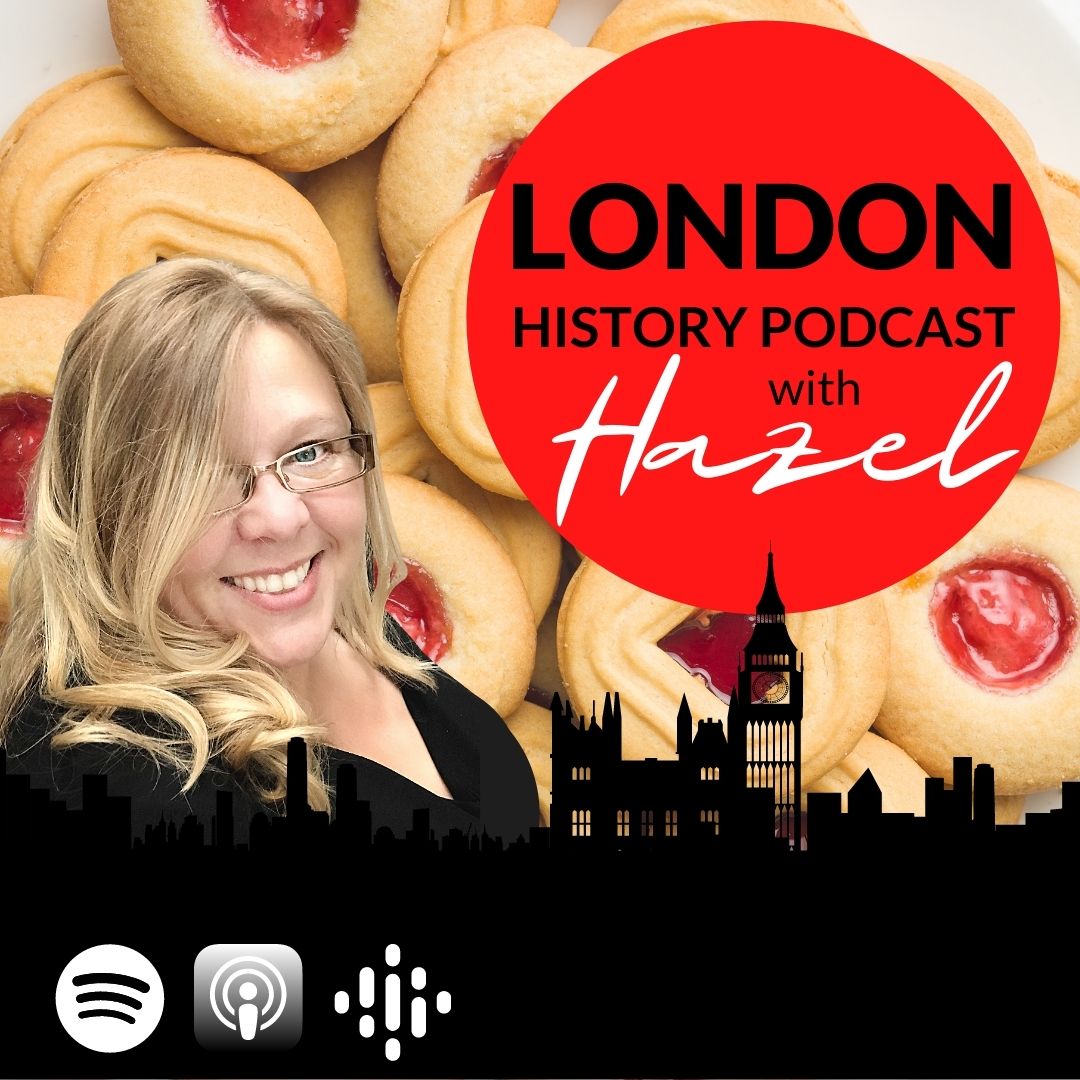Childhood Foods
Show Notes:

Your Host: Hazel Baker
Hazel is an active Londoner, a keen theatre-goer and qualified CIGA London tour guide.
She has won awards for tour guiding and is proud to be involved with some great organisations. She is a freeman of the Worshipful Company of Marketors and am an honorary member of The Leaders Council.
She has been an expert guest on Channel 5’s Walking Wartime Britain

Guest: Ian McDiarmid
Ian qualified as a City of London tour guide in 2017 and has a particular passion for Roman and Medieval history, having in an earlier incarnation studied history at Cambridge and London universities.
Hazel: Hello and welcome to London Guided Walks London History podcast. In the coming episodes, we will be sharing our love and passion for London, its people, places and history in an espresso shot with a splash of personality. For those of you who don’t know me, I am Hazel Baker, founder of London Guided Walks, providing guided walks and private tours to Londoners and visitors alike.
We’re lucky to have two guests on today’s episode. Returning to the studio is our erudite guide Ian McDiarmid.
Today’s episode was inspired by a conversation I had on Twitter where people were sharing their childhood foods, these included sugar sandwich and ketchup sandwich. For me, salt and vinegar crisps sandwiches were a big part of the fun of being a child as well as my mom’s mashed potato surprise and my granny’s apple pie.
What foods was it for you in your childhood that really brings back those feelings of nostalgia?
Ian: Well, it’s interesting listening to you, Hazel because in giving your memories, your foods that you cited, your views of them are universally positive. And following in that vein, I would look back on the puddings that we had as children and I think my absolute favourite was bread and butter pudding. However, looking back on food, I also have some rather disturbing memories, which are associated indelibly with school and in particular with primary school. And in particular, in my mind, standout spam fritters. And I can’t think, if somebody mentioned the word spam to me in passing, I feel slightly unwell still, immediately. It’s like a Pavlovian response.
Hazel: Hold on a minute. Spam fritters, what’s wrong with spam fritters? They’re crispy on the outside, they’ve got a lovely juiciness with the batter and the sweetness of the spam. I mean, what’s not to like?
Ian: I can already feel in my mouth the first symptoms as I’m beginning to feel slightly unwell, they’re disgusting. The batter was just pure grease and then inside the spam, it was just revolting, it had a horrible texture, horrible taste, a saltiness, yeah, very strange. It just tasted like we stuck together with glue and then the stuff on the outside. Yes, the spam fritters is my strong abiding memory, but the other one is semolina. Now, if I was having semolina, which perhaps I should explain to younger people because I don’t think I’ve seen it in the shops since I was a child, is I think it’s, really it’s similar to rice pudding, but much, much, much finer, so it’s sort of white in colour. And if I had that at home, I would really like it. It’s a milky pudding, but at schooling revolting, the grains of the semolina they weren’t cooked, and it had a kind of grainy texture and then they would always serve it up with raspberry jam. And so, the idea was that you’d stir the raspberry jam into it and the raspberry jam, well, obviously looking back was of such core quality so, you’d stir it in, and the whole thing would be bright pink. The two foodstuffs at the top of my list, I think it’s perhaps some significant reflection of our different personalities that you immediately reel off on the list of foods and you think how good they were, and I’m reeling off a list and I’m going on criticising them.
The other thing, apart from the spam and semolina which immediately stick out in my mind is just their horrible vegetables. I mean, the whole point about children is, and food, is you’re supposed to encourage them to eat vegetables and they just couldn’t cook. I mean, the vegetables, looking back they were always overcooked so the cabbage always tasted that being cooked for about 40 minutes so any texture it had, it would be destroyed. And then it was never served up hot, it was always lukewarm at best and covered in water, so it hadn’t been drained properly. So, there’s my immediate reactions to your question childhood memories of food and the bad ones come up, the bread and butter pudding is a positive one though.
Hazel: Yes. Now, when I asked our other guides what their favourite foods were as a child, Susan also said bread and butter pudding. So, you’re not alone with that. My mother’s bread and butter pudding wasn’t so great. When you bit into it, it tasted like it had been shot. Like, it’d been a piece of game because you get these little black pellets which were obviously supposedly currants or raisins or something, and you’d be picking those out of your mouth as you’re going. I can’t stand bread and butter pudding to this day, unless it’s Nigella Lawson’s recipe and she uses croissants, so, it’s all a little bit more refined. But no, I can’t do bread and butter pudding.
Ian: Nigella Lawson would use croissants, wouldn’t she?
Hazel: Well, she uses stale croissants, which of course don’t exist in our house, but you have to go out and croissants and then try and hide them for a day for them to go stale. So, yes, Susan for bread and butter pudding, you’re both up there, but she also said peanut butter and banana sandwiches.
Ian: No.
Hazel: No, Susan, I think you’re on your own on that one. I just, I mean, I did ask her, look, “Is it crunchy or smooth?”, and she said, “Smooth, but both are good.”. And I thought “No, I just don’t think I ever want to put that in my mouth. Thank you very much.”.
Ian: No, I agree with you. I mean, I think with sandwiches that they shouldn’t contain anything sweet. I mean, a little bit of relish maybe but the idea of sort of sugary sandwiches is a bit of a no no in my mind. I sympathise with you on the bread and butter pudding and I hope your mother doesn’t listen to this. I’m sure she won’t. Because, obviously at school, they tried to do bread butter pudding and that is exactly what they did to it. Now you mentioned it, it brought back the memories that the currants were actually rock solid and there’s nothing you can do with them when you’re trying to eat them. So, yeah, I remember that. And of course, the school version had absolutely no texture, it was just kind of a mush, it wasn’t really bread and butter pudding; it was kind of milky mush.
Hazel: At primary school, our cook was Mrs. Jordan, and she was fabulous. We, I mean, I remember at primary school trying my first moussaka and my first goulash, and I loved them, absolutely loved them. So, where I kind of think, and maybe you were a picky eater.
Ian: I kind of think that around, I was about to forget the name of my school there. I think 1960’s cafeteria, you would never get anything like moussaka and goulash, they would just– those are exotic foods. Those aren’t English so, it would be like oh no, I’m sorry, it’s unpleasant during this interview because it’s bringing back memories. Was it toad in the hole where you had the, because I’m vegetarian now, so it’s a bit difficult remembering what these things were. Oh dear. Oh, it was just horrible. I mean–
Hazel: What’s wrong with toad in a hole? Sausages and batter, I mean, you can’t go wrong.
Ian: Isn’t there sausage in Yorkshire pudding?
Hazel: Yeah, batter.
Ian: It sounds like a bad idea to begin with, but the sausages were, I can imagine looking back that they were sort of 80% fat and 10% pork or whatever. And then the Yorkshire pudding, it was disgusting. I mean, to me, yeah, it was when I was an adult, that I realised Yorkshire pudding can actually be quite nice.
Hazel: Oh, I’m feeling sorry for you and your childhood. I mean, I must agree with you about the semolina that reminded me of frogspawn.
Ian: Oh god. Yes. It’s funny talking to you now and just remembering all these foods and how appalling they were. I think we could, perhaps we could change subjects because otherwise we’re just going to go on until I’m just going to remember more and more horrible school foods as we go on.
Hazel: Well, changing the subject. I mean, why don’t you share some of your more positive experiences with food? First of all, you mentioned about puddings, and I know you mentioned in the past about castle puts or something, what are they?
Ian: Oh, yeah, castle puts are little sponge puddings made in small cylindrical moulds that’s tapered towards the top, so they look a bit like the turrets of castles. And I’m sure this has got another name to it, like syrup pudding or something. So anyway, just imagine a small amount of sponge with a small amount of syrup at the top. And they were fantastic, yeah, and the smell of those in the oven, that was brilliant. The puddings my mum made were fantastic. And then the other good food experience I had was going to Italy when I was 18. And, you know, not really knowing anything about Italy too much before going and then discovering the food there, just the way the Italians do food is just brilliant. I mean, it’s not fancy, it’s not complicated, it’s just an emphasis on fresh ingredients which you can actually taste. And also, I think I probably have a natural affinity for the things Italians like, the use of Herbs, and their coffee and everything. I mean, it tastes and smells good, and it was a real revelation going there. Yeah, a real epiphany with food I had at the age of 18 and realised that it could be really, really.
Hazel: So, Italy sounds like a really great experience for you. And you certainly love your food now. So, does that mean that you’re a good cook?
Ian: No. I think one thing that I bought home from Italy was I used to eat masses and masses of pasta, and I still love pasta. I mean, it is such a great food, quite easy to do something quite simple with. But no, I’ve never really mastered the art of cooking. I suspect that there’s too much on reading instructions which I’m not very good at. No, I’m not a good cook, but I do make a nice cup of tea.
Hazel: Well, that’s something I suppose. I’ll tell you what, put the kettle on while I introduce our next guest. Our next guest has had a profound effect on my own childhood, and that is my mom. How would you describe your childhood experience with food?
Hazel’s Mom: It’s varied really, depending on whether it was my experience at home or school. At home, my mother, for instance, lost her mother when she was about five years old. So, she had no real role model in the house apart from my grandfather, who cooked so many puddings, wrapped up in a tea towel, and was steaming for several hours, and one slice of this, whether it be spotted dick, which is made with currents, or a general Coralie just one size to feed the family of eight the whole day, that was the main meal. So, she can’t remember him cooking anything else but steamed puddings, but her older sister took over all the household duties at 14. I think she had very little experience as well so, my mother had no chance of learning how to cook as such. As a result, obviously she was inexperienced and just regarded food as something to stave off her hunger pains. And it gave a structure to the day, she thought about, breakfast, dinner and tea she called it. And tried to get it done with as quickly as possible.
Hazel: Did you have a favourite day of the week for meals?
Hazel’s Mom: I think Sunday was probably the best day of the week because we were well fed. We started with full an English breakfast, which was always cooked by my father, and that always contained black pudding, egg, which he kind of splattered the fat over to get it wide, bacon, fried bread and canned tomatoes.
Hazel: And what about Sunday lunch then?
Hazel’s Mom: Roast dinner was always for Sunday dinner, and we had it with Yorkshire pudding, which my mother’s Yorkshire puddings rose so high, they stuck to the shelf above, and when you got it detached you had to get two shelves out at once. And she just served it with beef, nothing else, just beef. And there was always apple pie with custard for pudding.
Hazel: Did you have other meats?
Hazel’s Mom: If we had pork, that was served with cracker and lamb with bean sauce, which was picked from the garden.
Hazel: And what about teatime?
Hazel’s Mom: For tea, we always had 10 pilchards in tomato sauce, or ham with a salad or a salad comprised of lettuce, boiled egg, tomato, cucumber, and sour cream.
Hazel: What about school lunches then?
Hazel’s Mom: I came home from primary school as most children did, and therefore we have someone like jacket potato and butter, or an odd combination was tomato soup with mashed potatoes. So, sometimes we had boiled very often we had sandwiches, bread and butter and jam but never dripping like some friends had on their sandwiches.
Hazel: Did you ever have sugar sandwiches or ketchup sandwiches?
Hazel’s Mom: No, we’ve heard of those but no, we never had them. And again, another tin this time of spaghetti on toast, that we would like lunch. And then dinner’s an assortment, spam fritters were one of my favourites, but my mother could make batter and her spam fritters were lovely and light. So, we had those. Something called steaklets, and they were the forerunner of beef burgers, they were a new thing on the market at the time and we had that at least once a week.
Hazel: Was there anything in particular that Nana really excelled at cooking?
Hazel’s Mom: Her fried chips were lovely to be honest; she really could cook chips and then we’d have tins of vegetables and we always had Morton’s processed peas.
Hazel: How did she make the chips?
Hazel’s Mom: In a deep-frying pan that was left out on the stove top so, whenever you went to the kitchen, it was there. And everything was cooked in lard, which is then, when it cooled, solidified. I never saw the pan washed out, just an extra helping of lard added to it if it needed topping up. I think she did try banana fritters now I think about it. That was exotic or unusual for my mother.
Hazel: What about fish and chips, did that play a part in your–?
Hazel’s Mom: That’s right, it’s the only takeaway that we had really, and to be honest, we had the fish without the chips or to be more precise, my father had a fish and my mother cooked her own chips. We never have fish from there from the chip.
Hazel: So, you had obviously the milkman and then making deliveries, did you have any other services?
Hazel’s Mom: Bread was delivered daily; an assortment of ice bundles and various cakes were also available if you wanted. If you wanted hot cross buns, you could order them and have them on Good Friday, that was the only day they were available. When I started my secondary education, I had to stay for school lunches, and I really enjoyed them. They introduced me to some new food that I never heard of or seen before. Chocolate concrete, which was served with either mint or raspberry flavoured custard, which as you try to break into it, shot off the dish and inevitably ended up on the table or floor. But we had such fun trying to tame that. And then, we were also introduced to sponges, school did the beautiful syrup sponge, golden syrup sponge or jam sponge, and they were a great favourite of mine.
Hazel: What about things that you weren’t so keen on?
Hazel’s Mom: Well, the thing I remember most was a milk pudding and I think it was semolina. I never tried semolina, never ate it, I think I tried it, but it was too coarse, and whenever we had a milk pudding that was served with prunes.
Hazel: The cooking that you did for your darling children, what were your biggest successes?
Hazel’s Mom: Successes?
Hazel: Successes, yeah, let’s start on a positive note.
Hazel’s Mom: Thank you. I thought, it’s up to you, you could tell me what my successes were. What did you enjoy the most?
Hazel: Well, I think we gave you instant feedback.
Hazel’s Mom: Yes, you liked spaghetti Bolognese.
Hazel: Yes.
Hazel’s Mom: But I never cared for that much, she didn’t tell me that often. I think you all liked my sannas. I think I did okay with that, and we served that with a salad or garlic bread. Garlic was part of an introduction, I never had garlic in my childhood. I don’t think I ever saw garlic until in my 20’s.
Hazel: I liked your toad in the hole. I mean, you made great batter, I know you think Nana did but, that was always lovely.
Hazel’s Mom: If you say so, but it was nothing in comparison to my mother. Nothing.
Hazel: And you did a good stew, and there were herbs in there sometimes.
Hazel’s Mom: Yeah, it was my mother’s stew and it was my innovation to put herbs in to add a bit of flavour because otherwise it was a bit dodgy and plain.
Hazel: Yeah, and sweet corn fritters?
Hazel’s Mom: Yes. I’ve forgotten about those. It’s not easy to get creamed sweet corn in a can now. Yeah, I find it difficult to find that, but when you were younger, yes, I could get that and made the fritters, and way of getting you all to eat some vegetables that was different.
Hazel: And what about your mashed potato surprise?
Hazel’s Mom: I think that was off my mother, just mashed potatoes with boiled egg mixed in and some cheese and semolina to give it flavour. I think she put in whatever she had left over from the week.
Hazel: There was one that I used to like. I never know really what you called it, but you used to do minced beef with onions with, I think it was gravy and other things mixed in, with an amputate mashed potato on the time.
Hazel’s Mom: The mashed potato went on the top because that was a recipe for cowboy pie. And the actual topping should have been corn flakes mixed with butter.
Hazel: What about your quiches? They went well.
Hazel’s Mom: Well, yes. I certainly fathered in our quiches.
Hazel: What about leftovers? What did you do with those?
Hazel’s Mom: I mean, I was brought up, you don’t waste food, you have something leftover, you did what you could with it. I made Chicken Pierre, made pies and mixed ham with the chicken. I’d do a variety thing, and I mean, chicken is so easy to get now and so easy to cook. But as I said before, in my childhood, I don’t– I think I was eight before we even had a chicken and then it was a rarity, it was a treat like, you know turkeys are a treat to Christmas.
Hazel: Big thanks to both Ian and my mom for sharing their childhood memories of food, including bread and butter pudding, spam fritters, and chocolate concrete.
Join us on Facebook, Instagram, and Twitter and share your childhood foods with us.
Thanks also to all those who have sent me lovely messages of encouragement for doing this podcast. It really is appreciated. Requests for future episodes have included London markets and London during World War Two. So, we’ll add those to the list. And if you have any suggestions for future episodes, or you want to join me on a podcast and share your memories or knowledge of London, then please visit londonguidedwalks.co.uk/podcast, and get in touch.














